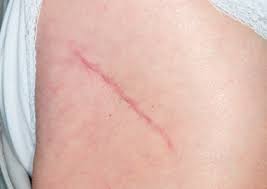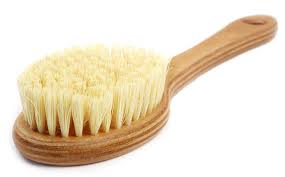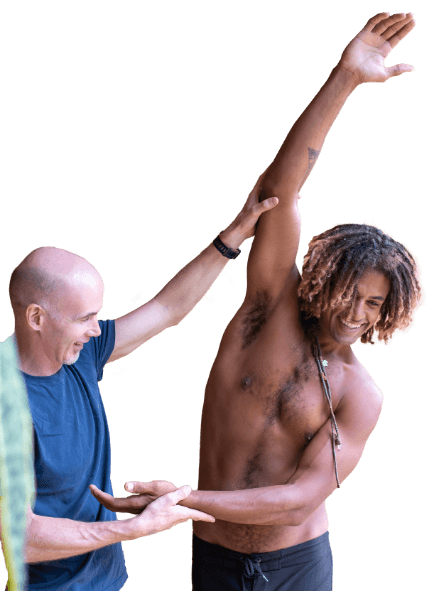Most people want to work with me because want to get rid of their pain. I’ve spent my career listening to people tell me about their back pain, their neck pain and their shoulder pain etc. But when it comes to chronic pain most people still make the mistake of associating pain with damage. Just today I was on a flight and I got talking to the lady next to me and she mentioned her painful knee.
The lady was in her mid 20’s and had hurt her knee a year ago playing basket ball. She’d seen a knee specialist and was diagnosed as having a medial ligament sprain, with no damage to the meniscus or other structures in the knee. This was confirmed with an MRI. Following her doctors advice she had spent thousands of dollars on physio or physical therapy but was still in pain.
So what is going on here?
Was the ligament still injured?
Maybe, but it’s unlikely as the body heals, especially after a year.
 It might be helpful here to think how a deep cut would heal. After a few weeks it would have scabbed over but essentially the skin would be back to being waterproof(ish) and it it would be less painful to touch. Fast forward another couple of weeks the scab would have fallen off to reveal a pink scar. The scar would be permanent but essentially the skin would have healed. We know that the scar tissue will never be as strong as the original, studies show it to be about 80% as strong, but to all functional purposes we would be fine and never really have to think about it again. However, it’s not uncommon for a scar to still have some pinkness even after a year, and for it to be still slightly sensitive to touch. So it’s not fully healed, but it’s getting there. The same happens on internal structures like ligaments. So, her knee ligament would most likely have healed but it might still have a little more to do.
It might be helpful here to think how a deep cut would heal. After a few weeks it would have scabbed over but essentially the skin would be back to being waterproof(ish) and it it would be less painful to touch. Fast forward another couple of weeks the scab would have fallen off to reveal a pink scar. The scar would be permanent but essentially the skin would have healed. We know that the scar tissue will never be as strong as the original, studies show it to be about 80% as strong, but to all functional purposes we would be fine and never really have to think about it again. However, it’s not uncommon for a scar to still have some pinkness even after a year, and for it to be still slightly sensitive to touch. So it’s not fully healed, but it’s getting there. The same happens on internal structures like ligaments. So, her knee ligament would most likely have healed but it might still have a little more to do.
I’ve treated many people over the years that told me that their scars were still sensitive and that they didn’t like people touching them. We know that the actual tissue is fine so it’s the brain’s hyper sensitivity or over reaction to a previously injured area that causes the sensitivity to touch. Essentially the brain’s awareness of this area is turn up. The good news is there is a simple fix, the way to decrease the sensitivity of a scar is to progressively simulate it.
One of my favourite ways to do this is to use a dry skin brush. This is  essentially a shower brush without that doesn’t get wet. I ask people to gently rub over the scar area, gradually increasing the time they do this a little every day. After a few weeks the scar is usually less sensitive and they should be able to tolerate more touch in the area. I ask them to continue with the daily dry skin brushing until there is no hypersensitivity left, this can take a lot longer, sometimes months rather than weeks.
essentially a shower brush without that doesn’t get wet. I ask people to gently rub over the scar area, gradually increasing the time they do this a little every day. After a few weeks the scar is usually less sensitive and they should be able to tolerate more touch in the area. I ask them to continue with the daily dry skin brushing until there is no hypersensitivity left, this can take a lot longer, sometimes months rather than weeks.
So what is happening here?
What is making the scar less sensitive?
It’s not that the scar is continuing to change, and that is especially true if the scar is older than a year because all the healing would have happened by then. So, what we are really changing is the brain’s response to stimulus. By rubbing the scar the brain is getting more information from that area, all the little receptors are being stimulated and the brain is getting a rush of information that initially it might interpret as pain. The reason for this is that impact, pinch, itch, tickle, hot, cold and crude touch are all communicated to the brain via the pain pathways (c-fibres). So when you rub it with a brush the brain receives all that information and essentially asks itself,
“What happened the last time we experienced a deluge of information from that part of the body?”
Oh yeah – “we got that nasty cut!”
So, the brain doesn’t want us to be injured so wants to stop that activity. The most effective way for the brain makes us stop doing the thing we are doing to cause that sensory barrage is to make it feel painful, then we will stop doing it.
But it doesn’t want to go through an elaborate thought process every time as that uses too much energy and from an evolutionary point of energy is precious. Now, to make things automatic and therefore use less energy the brain sets up a little electrical loop, using nerves or neurons like this: movement-pain-neural-circuit – This can be summarized by the phrase, “neurons that fire together wire together.”
That’s a neat little survival mechanism for our species, which means that over time this circuit has worked often enough for survival that it has been selected into our collective physiology…but it’s not always in the best interest of the individual.
It doesn’t need to fire off like that.
That is why I ask my patients to keep rubbing the area. The brain then starts to revisit its initial response.
It starts to ask the question,
“Is anything bad happening here?”
The answer comes back from the body that “No, there is no damage being done by this activity”
But the brain doesn’t like to be fooled, so it doesn’t change that neuronal network straightaway.
However, the more times the scar gets rubbed, the more times the body reports no damage, then the network will slowly stop firing. As there is no actual damage being done and the brain doesn’t need to produce the pain response, the network will, over time, be dismantled, “neurons that fire apart, depart.”
This is how we desensitize a scar.
So, what’s this got to do with the lady I met on the plane.
Well, she had full range of motion in her knee, the physio had tested the integrity of her ligaments and they were fine but she still got pain on certain movements. This is an example of a knee but this can equally be applied to the back, shoulder, necks, ankles etc.
So, over the course of the year, it is most likely that her body developed a hypersensitivity to her knee being moved essentially misinterpreting movement for pain.
How do we help this lady? Is the best course of action manual therapy, massage or some magic knee technique she hasn’t had yet? Probably not, she’s had a year of physical therapy and it hadn’t worked.
Perhaps we should send her back for another MRI, (that’s what she wanted) as she was still thinking that there must be some sort of structural damage in her knee. An MRI could be an option, but unless she paid for it privately it could take months (in Canada and the UK) and what would it show that manual testing hadn’t already shown?
What she hadn’t done, or what she had avoided was actually exercising it.
Over the last year this would have led to a decrease in muscle strength, fear, fixation on pain and hypersensitivity.
Now, she is in a Catch 22, if she uses her knee it’s painful, but not using it is making it weaker which leads to a downward spiral of inactivity, weakness and pain.
So we need to ‘course correct’ and there are two ways of doing that.
Not on the knees, but with the knees just an inch or two above the floor (see video). In this position the knee is flexed, but it isn’t being loaded in the normal way. Using novel movements like this commonly ‘tricks’ the brain because it hasn’t got a frame of reference for it. So, in the squatting exercise we would be ‘playing’ on the edge of what the brain thought was damaging. However with the crawling we could easily be bent more than 90 degrees with no pain. There are literally thousands of exercises we could do here, but the idea is to get the biggest strength gains without stimulating the brain. Over time the brain will go through the same process of assessing damage, realizing that there is none and the movement-pain-neural-circuit will slowly “fire apart – depart” and she will be able to enjoy basketball again.
Interestingly if we look at both of these methods from an evolutionary point of view we can see why they both work. Imagine our lady lived hundreds of thousands of years ago and hurt her knee out on a hunt. She would have been able to rest it for a few days as her family took care of her but the hunting party or tribe would have wanted her to pull her weight pretty soon after the injury. So she would have gone back out either hunting or gathering but avoiding movements that stressed her knee too much. But she certainly would have been moving up to 6 hours a day.
As the tribe got ready to move she would have had to help pack up and prepare for the nomadic travels again, all the time exposing her knee to different movements that involved strength, mobility, coordination, balance etc. She would have been performing these graded desensitization exercises for hours a day every day no breaks and in order for her to survive her knee would have got better. She wouldn’t have had a choice. But now, in the modern era our lady simply doesn’t have the environment to perform her own rehabilitation like that. She probably spends the majority of her day sitting (she was a student) and her movement repertoire is probably very limited. No climbing, no jumping, no walking log distance over uneven terrain.
With this in mind my approach to almost all my clients who suffer from chronic pain is a movement-based one. I keep in mind how our body evolved and what it is designed to do. I then encourage my clients to not be afraid of pain but instead to dance with it so that the brain has a chance to rewire.

Over the last 10 years Ed has been building a YouTube library to help people manage their own pain or movement limitations and increase performance through exercise. He regularly adds videos so be sure to subscribe and visit regularly


"Oh My Gosh- I am ALREADY feeling relief after a few days! I used to wake up 2-3 times a night with shooting pain that anti inflammatories couldn't touch. Now I have been waking up just because I want to notice what it feels like to lay in bed pain free- THANK YOU!."

"When I first started with your program I was experience a lot of pain. Walking was difficult. I had to stop and catch my breath every few minutes and lean against a wall for support. Now when I walk with my husband we go for over an hour. I never had to sit down and stop...and, hardly any pain!!! 😊😊 I can’t thank you enough."
Frustrated that you aren't recovering fast enough?
Discover how to heal from illness and injury using movement, food and lifestyle.
Leave a Reply